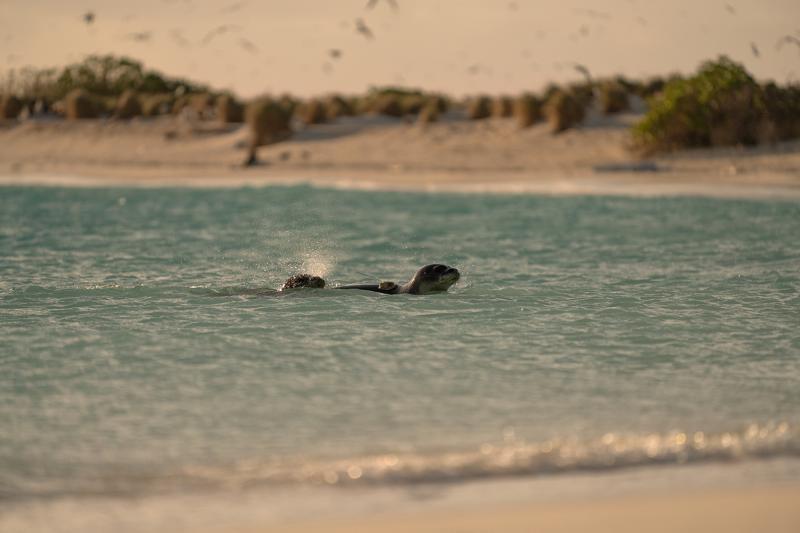
Rehabilitated Hawaiian Monk Seals return to Kuaihelani
by NOAA Fisheries 7 Apr 2023 21:23 UTC

Rehabilitated Hawaiian monk seals explore their new habitat after a successful release into the wild at Kuaihelani (Midway Atoll) © USFWS/Andy Sullivan-Haskins (NOAA Fisheries Permit #23459)
Three monk seals return to Midway Atoll at Papahanaumokuakea Marine National Monument after struggling with malnourishment. They now have a second chance at survival.
Three endangered Hawaiian monk seals are back in the wild at Papahanaumokuakea Marine National Monument, thanks to a partnership between NOAA Fisheries, The Marine Mammal Center, the U.S. Coast Guard, and the U.S. Fish and Wildlife Service. The rehabilitated seals have a new chance to thrive at Kuaihelani (Midway Atoll).
NOAA Fisheries observed the malnourished juvenile seals in 2022. After an intensive search and rescue effort, they spent months plumping up at The Marine Mammal Center's Ke Kai Ola hospital. Then they were carefully released at Kuaihelani in March 2023. The young seals are now off to a good start back in their home range.
Check out photos from the Hawaiian monk seal release effort.
Rescue and Return
A rescue in the most remote reaches of the Hawaiian monk seal's range is a challenge. Hawaiian monk seals don't always make themselves easy to find. With just 2 days to locate and safely prepare the malnourished seal PP32 (Alena) for transport, NOAA Fisheries staff were thrilled to successfully bring her aboard the NOAA ship Oscar Elton Sette. They also rescued another malnourished seal, DQ10 (Lelehua), on the same trip. The pair joined WQ08 (Ikaika), who they rescued on a previous cruise, at The Marine Mammal Center's Ke Kai Ola hospital on Hawai'i Island in 2022.
Seal patients at Ke Kai Ola are ready for release after they gain enough weight from feeding on their own and passing a release exam with a clean bill of health. That process can take anywhere from weeks to months depending on the seal patient's ailment, age, and body condition. But transportation via ship isn't always readily available. That means that they can spend extra months in care just waiting for a lift. For these three patients, NOAA Fisheries needed some extra help to get them home.
In early March, NOAA Fisheries called the U.S. Fish and Wildlife Service, a co-manager at Papahanaumokuakea. They offered access to the runway and facilities on Kuaihelani, where they operate the Midway Atoll National Wildlife Refuge and Battle of Midway Memorial. They also provided helping hands to release the seals.
Next, the seals needed a way to get there. The U.S. Coast Guard, another important conservation partner, stepped in and were able to provide a plane and flight crew.
A "Soft" Release: From Rehab to Remote Shores
It was a tranquil day in March 2023 at Kuaihelani. On a white sandy beach, staff heard a guttural "bahhh" from close by: A juvenile Hawaiian monk seal was vocalizing at its two pen mates. The seals play-wrestled in a shaded beach enclosure fashioned from aluminum fence panels and bungee cords.
The return to the wild for PP32 (Alena), DQ10 (Lelehua), and WQ08 (Ikaika) involved a 3-day pre-release acclimation period, known as a "soft release." Staff monitored the seals and their surroundings while staying just out of view.
When U.S. FWS released the seals from the beach pen, everyone was delighted to see them calmly ease their way into the water at Kuaihelani.
"The Midway Atoll community is really excited to see these three monk seals adapting to their new home," said Amanda Boyd, deputy superintendent for Papahanaumokuakea Marine National Monument. "Midway Atoll National Wildlife Refuge provides ideal foraging, resting and breeding habitat to [more than] 70 Hawaiian monk seals."
"Survival of each [seal]... [is] critical to the recovery of the population," added Dr. Sophie Whoriskey, Hawaiian monk seal conservation veterinarian at The Marine Mammal Center. "This success story highlights the critical importance of our ongoing partnerships to help give these animals a second chance at life."
What's Next for These Seals?
Even though the seals were released at healthy weights, they still face many threats in the wild. NOAA Fisheries will monitor them using satellite tags and unique individual flipper tags.
"We're working to understand all of the factors that influence rehabilitated monk seals' survival," said Dr. Michelle Barbieri, lead scientist with the NOAA Fisheries Hawaiian Monk Seal Research Program. "Observing their movement patterns over time helps inform how well the seals are acclimating post-release."
NOAA Fisheries will continue to study the Hawaiian monk seal population, intervene to save seals, and examine the effectiveness of conservation actions.
"With threats like climate change, the solutions of the future may not look like those of today," said Barbieri. "... but with commitment, community support, and a little creativity, we will help this species thrive."
Learn how climate change is impacting Hawaiian monk seals at Papahanaumokuakea.
Follow Seals in Near Real Time
Do you want to see what Hawaiian monk seals PP32 (Alena), DQ10 (Lelehua), and WQ08 (Ikaika) are up to now? Follow them in near-real time through the U.S. Integrated Ocean Observing System Animal Telemetry Network.
Find out how NOAA Fisheries tracks monks seals through the IOOS Animal Telemetry Network.